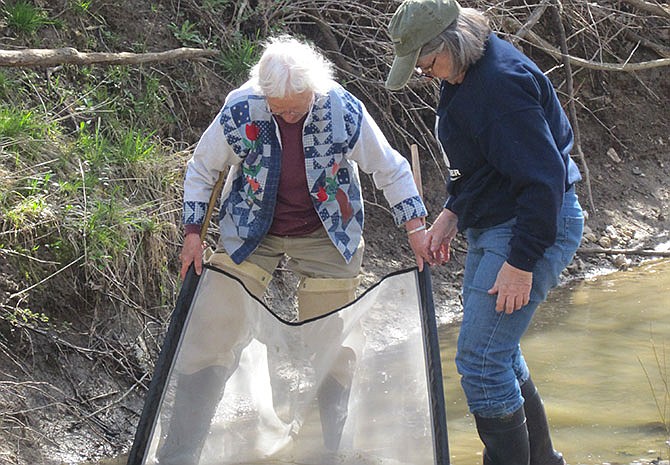A June 2015 audit by the Missouri Department of Natural Resources (DNR) has spawned a push by the City of Fulton to clean up its act in relation to Stinson Creek, which in turn has created a need for funds. That need for funds is reflected in the current call for a half-cent sales tax to be voted on by the public on Tuesday.
As early as the 1990s, Stinson Creek was listed as "impaired' by DNR and the Environmental Protection Agency (EPA).
According to DNR, the federal Clean Water Act requires each state identify waters not meeting water quality standards. Water quality standards protect such beneficial uses of water as human recreation, maintaining the health of aquatic life, and providing drinking water for people, livestock and wildlife.
The waters of Stinson do not affect the drinking water in Fulton, city officials said. But they do play a huge role in the process required to gain permits for both the wastewater and stormwater systems.
"We knew there were deficiencies," Kyle Bruemmer said of how the stream was managed. "But we also knew that making it right was going to cost money. And we knew the Department of Natural Resources wasn't really enforcing the requirements for the permits."
Bruemmer, interim city engineer, said all that changed with the 2015 audit.
The issue is somewhat of a domino effect when it comes to Stinson Creek. The city must be able to off-load wastewater and stormwater into the creek, but if the creek is already at the highest levels of what it can take in and remain healthy, the city cannot get permits to off-load any other waters.
The wastewater treatment plant already cleans water before releasing it into the creek, but there are improvements being made on that end as well.
"If people drive by the water treatment plant, they will see a lot of construction already happening there," Bruemmer said.
But stormwater is also an issue. Most is surface run-off, which means there is no clean-up before it hits Stinson.
Bruemmer noted stormwater run-off can include things like chemicals that people spray on lawns or oil from a business.
The engineer is writing new ordinances that will help the city enforce measures to keep the water clean.
"One of the priorities we face is illicit discharge and detection," Bruemmer said. "We are going to start monitoring the water, which will help us pinpoint where the problems are and how to remedy them."
Bruemmer also said the city will be educating and engaging the public. "We're going to have to change our behaviors as citizens. We have to create public awareness," he said.
The city has created a Stream Team that includes not only city employees but public volunteers. While they will be physically cleaning trash from the stream, they also will have members trained by the Missouri Department of Conservation's (MDC) Stream Team program to monitor the health of the water with chemical and site tests.
"A city-backed Stream Team should stand the test of time because they will always have to be meeting permit requirements," Bruemmer said.
Getting the public involved should be a fairly easy part of DNR requirements. Multiple groups have shown an interest over the years in the health of the stream. Westminster College and William Woods University both have student groups that monitor the streams via classes and extracurricular activities.
There is also an active MDC-sanctioned Stream Team in North Callaway County. The team was organized by residents who are concerned about water quality should installation of a proposed Concentrated Animal Feeding Operation (CAFO) come to fruition. They have been monitoring for a baseline of stream health for the past year.
The city is also in the process of hiring a new construction and stormwater inspector. There has long been an inspector for construction sites, but the addition of stormwater responsibilities is another way to meet permitting requirements by making certain erosion from construction is contained in detention ponds and not flushed into the creek.
But a large portion of the funds required for this systematic overhaul will go to finding out why stormwater is flooding the wastewater system. Currently, if rains are heavy, the overflow of stormwater floods the wastewater system, which is unable to keep up with the necessary processing. The overflow of water then flushes into Stinson Creek.
"I imagine there are probably problems with both systems that are causing this to happen," Bruemmer said.
Of the $750,000 the city hopes to generate annually with the half-cent sales tax increase, half would go to stormwater improvement projects and stream clean-up.
An email from DNR states as of 2010, Stinson Creek is no longer included on the impaired waters list after the city made a plan via the EPA to address the impairment.
But the city is held accountable to their compliance via the permitting process every five years.
According to an email document provided by Bruemmer, storm permit requirements for the City of Fulton are as follows:
• educate and involve its citizens on stormwater pollution and prevention
• detect and eliminate sources of pollution
• manage city facilities in a way that promotes a clean environment
• control the release of stormwater from new and redeveloped construction projects.
"We will have to work with the community to solve this problem," Bruemmer said.
"The organizing factor of the Stream Team will help break down any barriers between groups that are working on this, so that it becomes a benefit to everyone. It's the only way to make progress," he said.

